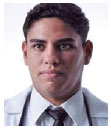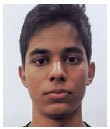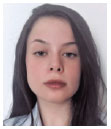Celso Marcelo Cunha1; Giovanna Marchezine1; Marcel Leão1; Gil Carlos Rodrigues Pinto1; Jessica Teixeira Cunha2; Pedro Lucas de Souza Cunha3; Ana Lívia Piovezan Oliveira4
DOI: 10.17545/eOftalmo/2019.0031
ABSTRACT
The accommodative spasm happens due to continuous contraction of ciliary muscle, thus resulting in low far visual acuity and asthenopic symptoms. There are some options for treatment, varying from the reduction of time of close-focus activities, the use of positive lenses (or less negative for the nearsighted) and the use of cycloplegic eye drops, which are often used as eye drops for weeks at the commercial concentrations, leading to frequent side effects and recurrence of spasms. In spite of all these treatments, there is no standardized treatment for this condition. In this work, it is reported three cases treated with low concentrations of atropine, associated with reduced overtime in close activities, with virtually no reported side effects, with spasm resolution in about four weeks, suggesting this approach as an option for effective treatment.
Keywords: Ocular refraction; Spasm; Atropine; Case reports.
RESUMO
O espasmo acomodativo ocorre pela contração contínua da musculatura ciliar, resultando, consequentemente, em baixa acuidade visual de longe e astenopia. Existem algumas opções de tratamento, desde a redução de tempo prolongado em atividades com foco de perto, uso de lentes positivas (ou menos negativas nos míopes) e o uso de colírios cicloplégico, que, muitas vezes, são usados por semanas, nas concentrações comerciais encontradas, levando a efeitos colaterais frequentes e recidivas do espasmo. Apesar de existirem todas essas opções, não há um tratamento padronizado para esta condição. Relata-se, por sua vez, três casos tratados com atropina em baixas concentrações, associada à redução do excesso de tempo em atividades de perto, praticamente, sem efeitos colaterais reportados, com resolução do espasmo em cerca de quatro semanas, mostrando ser esta uma opção de tratamento eficaz.
Palavras-chave: Refração ocular; Espasmo; Atropina; Relatos de casos.
INTRODUCTION
Accommodative spasm (AS) is an involuntary and sustained contraction of the ciliary muscle, which does not allow return to the normal tonus of this muscle and induces or increases pseudomyopia, which can be abolished (or reduced) with cycloplegia(1). AS can present with alteration of accommodation alone or be associated with myosis and/or esophoria (sometimes esotropia)(2). The most frequent cause is functional, associated with excessive up-close tasks, and the condition affects patients up to the third decade of their life(3). However, some cases may be associated with organic causes of AS or pseudomyopia alone, such as disorders that affect the midbrain or the cerebellum, psychiatric disorders, diabetes mellitus, iridocyclitis, and post-traumatic disorder, or with drug interactions and prolonged use of sulfonamides, anticholinesterase drugs, topiramate, or pregabalin(3-5).
The digital world has facilitated the development of various professions as well as increase in the diversification of leisure and social interactions, which have led to individuals using near vision for longer periods than in past decades.
AS treatment can be environmental, optical, or pharmacological. There has been no standardization of the treatment, and although pharmacological treatment with cycloplegic eye drops (1% atropine or 1% cyclopentolate) is often used, it is associated with complaints of side effects (mydriasis and cycloplegia)(3).
In the last decade, low-concentration atropine (LCA) has been indicated for reducing myopia progression (RMP) in children and adolescents, with little mydriatic and cycloplegic effects(6,7).
In case reports presented herein, patients were prescribed LCA with reduced time spent performing up-close tasks AS treatment.
CASE REPORTS
Case 1
A 19-year-old male patient, student, presented with a history of blurred distance vision for the last 2 days. He denied trauma or medication use. Ophthalmological examination showed the following: VA without correction of 0.2 and 0.15; VA with correction of 1.0 in both eyes; refraction without cycloplegia of -3.00 and -2.50 D; and refraction with cycloplegia of +0.50 and +0.75 D, with instillation of one drop of anesthetic eye solution (proxymetacaine hydrochloride, 1% cyclopentolate, and 1%tropicamide) at intervals of 2 minutes. Cover test revealed the following: orthophoric/orthophoric’ for near vision (ortho/ortho’); biomicroscopy without changes; and normal eye fundus. Atropine (0.01%) at night for 2 weeks was prescribed with reduced time of continuous up-close tasks to a maximum of 30 minutes, with 10 minutes of rest between them, if possible, and staying indoors (functional and environmental therapy; FET). The patient returned 3 weeks later, with no complaints about the treatment and with VA of 1.0 without correction.
Case 2
A 30-year-old male patient, IT technician, presented with a history of blurred distant vision in the last 3 months. He reported frontal trauma in a car accident a year before. He denied the use of medication and wore glasses (-2.00 -0.75 160° and -2.25 -1.00 20°). Ophthalmological examination revealed the following: VA with glasses of 0.4 and 0.33; VA with correction of 1.0 in both eyes; refraction without cycloplegia of -3.25 -0.75 160° and −3.50 -1.25 20°; and refraction with cycloplegia of +0.25 -0.75 155° and +0.25 -1.00 160°. Cover test revealed the following: ortho/E’ 8 PD; biomicroscopy without changes; and normal eye fundus. Glasses with refractive power measured by cycloplegic refraction. Atropine (0.01%) at night for 4 weeks was prescribed in addition to FET. He returned a month later with complaints of close vision problems when reading a book at a distance of <30cm; however, distance VA was normal. The patient was instructed to use the eye drops for 2 more weeks and return after 2 weeks without eye drops. He returned 3 weeks later without symptoms.
Case 3
A 25-year-old female patient, university student, presented with a history of blurred distance vision in the last two months. She used to wear rest glasses but had lost them 6 months before and no longer wore them. She denied trauma or medication use. Ophthalmological examination revealed the following: VA without correction of 0.01 in both eyes; VA with correction of 1.0 in both eyes; refraction without cycloplegia of -7.00 and -6.50 D; and refraction with cycloplegia of -0.50 and -0.75 D. Cover test revealed the following: ortho/ortho’; biomicroscopy without changes; and normal eye fundus. Atropine (0.01%) at night for 2 weeks and FET were prescribed. The patient returned 2 weeks later with complaints of blurred distance vision (refraction without cycloplegia: -2.50 and -2.00 D). She was then prescribed two drops of atropine (0.01%) at night, at an interval of 5 minutes. She returned 3 weeks later without complaints regarding the treatment and with a VA of 1.0, with optical correction as previously found in cycloplegic refraction. She was prescribed glasses (-0.50 and -0.75 D) and a drop of atropine (0.01%) for another 4 weeks. She returned 2 months later, wearing glasses and with a VA of 1.0 in both eyes, with correction.
All patients signed an informed consent form for the use of off-label medication.
DISCUSSION
The digital wave has invaded and changed the lifestyle of billions of people around the world. Portable electronics (tablets and smartphones) are used by children at an increasingly earlier age; they grow up using them in numerous tasks that often lead to the use of the up-close vision (8cm to 12cm from the eyes) for long periods, despite the restrictive recommendations of the American Academy of Pediatrics and of the Brazilian Society of Pediatrics(8,9). This excessive use has predisposed children to eye disorders such as AS and myopia progression(10,11). In addition, it predisposes children to obesity and behavioral changes in general(12).
For AS diagnosis, one should not simply consider the pre-cycloplegia refraction data provided by the auto-refractors but rather the lowest subjective refraction that achieves the patient’s best vision, preferably by performing fogging(13).
Patients with AS may present with complaints of headaches, asthenopia, low distance visual acuity (pseudomyopia), visual oscillation, diplopia, and macropsia. On clinical examination, refraction without cycloplegia is significantly less (absolute value, i.e., more shortsighted) than that with cycloplegia(3). Myosis and/or esophoria can also be found. There are case reports of esotropia with temporary abduction limitation(14). In such cases, the main differential diagnosis should be performed with sixth nerve palsy in which miosis is absent. Other differential diagnoses should be considered, including amblyopia, acquired esotropia, and use of drugs that cause pseudomyopia, such as sulfonamides, topiramate, and pregabalin(3-5).
Although there is no consensus on AS treatment, 1% or 0.5% atropine has been used in ophthalmic clinical practice for this purpose since 1884(15). Another cycloplegic drug used for this purpose is 1% cyclopentolate, and both are associated with frequent relapse of AS and treatment discontinuation due to side effects(1,3).
Atropine for RMP has been reported since 192; however, only with the use of LCA, it started being widely used for again this purpose due to its association with few mydriatic and cycloplegic effects (at concentrations of 0.01%-0.05%)(6,7,16-20).
The described patients used atropine at 0.01% and 0.02% (two drops followed by the third case), and their symptoms improved within four weeks; however, they used the eye drops for 4-6 weeks to avoid early relapse, with no reports of side effects except for difficulty in focusing on very close objects. In functional AS, the trigger is excessively prolonged near work activities; therefore, advising the patient regarding better environmental control with the aforementioned FET is mandatory(21).
Optical treatment of AS has also been indicated, with better results obtained in cases with small degree of pseudomyopia (on average 2.50 and 2.00 D), with the use of temporary hypocorrection in myopia or of positive lens in mild farsightedness(21,22).
To establish the initial pattern of treatment, AS treatment should be related to its severity. Small amplitude functional AS (pseudomyopia of ≤3 D) is initially well controlled with FET and positive lenses or accommodative occupational lenses or with LCA. In AS of high amplitudes (pseudomyopia of >3 D), in addition to these environmental measures, LCA use for 4-6 weeks is beneficial.
Herein, LCA was shown to be effective, well tolerated, and inexpensive for AS treatment. Further studies are necessary to determine the most effective concentration of this drug for this disorder.
REFERENCES
1. Von Noorden GK. The near vision complex. In: Von Noorden GK, editor Binocular vision and ocular motility: theory and management strabismus. 4thed. St. Louis: Mosby; 1990. p. 85-6.
2. Hussaindeen JR, Mani R, Agarkar S, Ramani KK, Surendran TS. Acute adult onset comitant esotropia associated with accommodative spasm. Optom Vis Sci. 2014;91(4 suppl 1):S46-51.
3. Goldstein JH, Schneekloth BB. Spasm of the Near Reflex: A Spectrum of Anomalies. Surv Ophthalmol. 1996;40(4):269-78.
4. Sen HA, O´Halloran HS, Lee WB. Topiramate-Induced Acute Myopia and Retinal Striae. Arch Ophthalmol. 2001;119(5):775-7.
5. Pascaretta VAD, Bisneto OS. Miopização relacionada ao uso de Pregabalina. eOftalmo. 2018;4(4):144-6.
6. Chia A, Chua WH, Cheung YB, Wong WL, Lingham A, Fong A, Tan D. Atropine for the Treatment of Childhood Myopia: Safety and Efficacy of 0.5%, 0.1%, and 0.01% Doses (Atropine for the Treatment of Myopia 2). Ophthalmology. 2012;119(2):347-54.
7. Cunha CM, Nunes EC, Queiroz FS, Santos Neto FR, Cunha JT, Correia RJB. Tolerância ao colírio de atropina 0,025% em crianças míopes. In Congresso CBO, Recife. 2014. Arq Bras Oftalmol. 2014;77(4 Supl):9.
8. American Academy of Pediatrics. Policy statement: Children, adolescents, and the media. Pediatrics. 2013;132(5):958-61.
9. Sociedade Brasileira de Pediatria. SBP. Saúde de crianças e adolescentes na era digital. Manual de orientação. Departamento de adolescência e col., outubro de 2016.
10. Puchalska-Niedbał L, Kulik U, Czepita D. Predisposition of 7-10-year-old children to accommodative spasm – findings from studies on the quality of binocular vision Pomeranian. J Life Sci. 2017;63(4):34-7.
11. Huang HM, Chang DS, Wu PC. The Association between Near Work Activities and Myopia in Children-A Systematic Review and Meta-Analysis. PLoS One. 2015;20;10(10):e0140419.
12. LeBlanc AG, Katzmarzyk PT, Barreira TV, et al. Correlates of Total Sedentary Time and Screen Time in 9–11 Year-Old Children around the World: The International Study of Childhood Obesity, Lifestyle and the Environment. PLoS One. 2015;11(6):e0129622.
13. Alves MR. Testes objetivos e subjetivos do exame de refração. In: Schor P, Uras R, Haddad MAO. Óptica, Refração e Visão Subnormal. Cultura Médica: Guanabara Koogan. 3° ed. Rio de Janeiro, 2013.
14. Griffin JF, Wray SH, Anderson DP: Misdiagnosis of spasm of the near reflex. Neurology. 1976;26:1018-20.
15. Fitzgerald CE. Acute spasm of the accommodation. Trans Ophthalmol Soc UK. 1884;4:311-5.
16. Gimbel HV. The control of myopia with atropine. Can J Ophthalmol. 1973;8(4):527–32.
17. Ekdawi NS, Cunha CM. Survey of Atropine for the Control of Myopia. In AAPOS meeting, San Diego. 2019.
18. Fang PC, Chung MY, Yu HJ, Wu PC. Prevention of myopia onset with 0.025% atropine in premyopic children. J Ocul Pharmacol Ther. 2010;26(4):341-5.
19. Cunha CM, Correia RJB, Cunha JT. Decrease of myopia progression with 0.025% atropine. Rev Bras Oftalmol. 2018;77(2):72-5.
20. Yam JC, Jiang Y, Tang SM, et al. Low-Concentration Atropine for Myopia Progression (LAMP) Study. Ophthalmology. 2019;126(1):113-24.
21. Álvarez-Bulnes O, Monés-Llivina A, Cavero-Roig LI, Valle-Chaparro P, Clavé-Cerezo L. Espasmo acomodativa em la infancia. Acta Estrabológica. 2018;2:107-12.
22. Cámara-Castillo HG, Díaz-Rubio JL, Jiménez-Rosas F. Tratamiento del espasmo de la acomodación con lentes esféricas positivas. Rev Mex Oftalmol. 2006;80(5):282-4.
AUTHOR'S INFORMATION



Funding: No specific financial support was available for this study
Parecer CEP: Não aplicável.
Disclosure of potential conflicts of interest: None of the authors have any potential conflict of interest to disclose
Received on:
June 2, 2019.
Accepted on:
October 21, 2019.